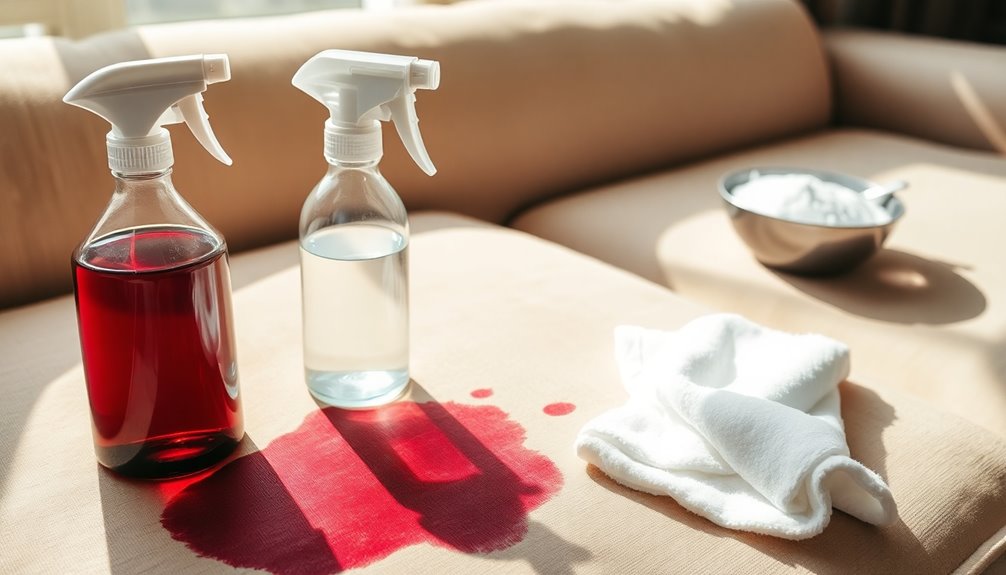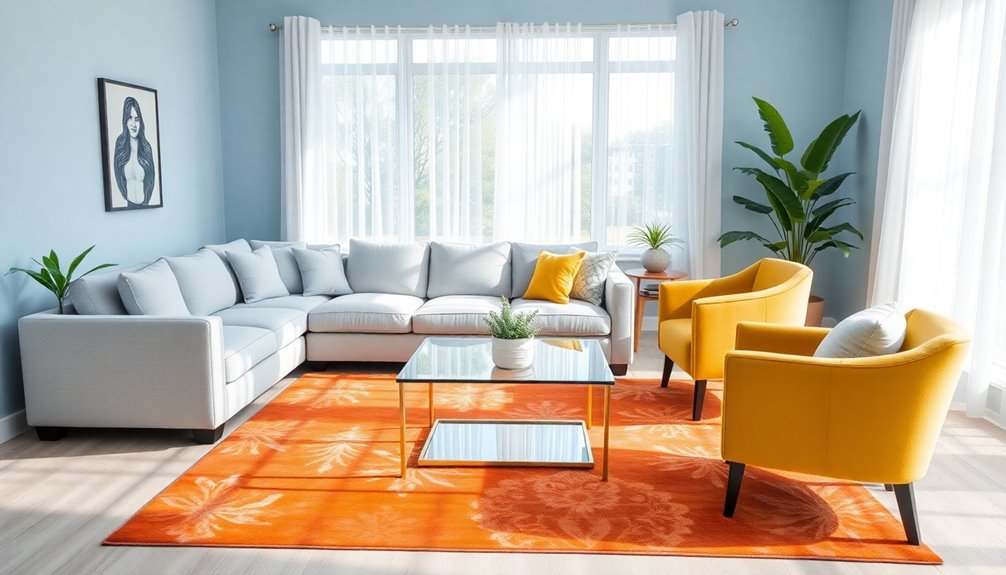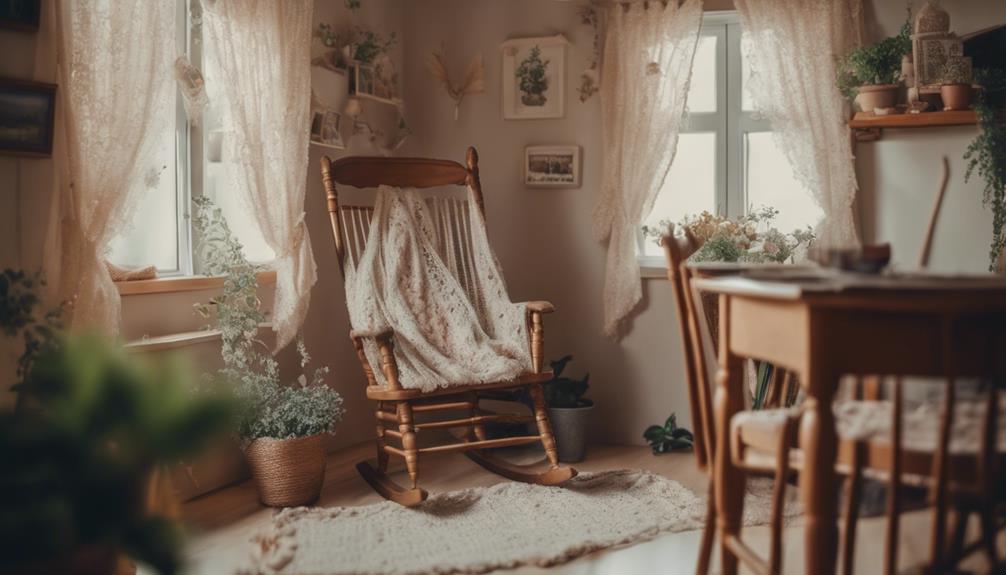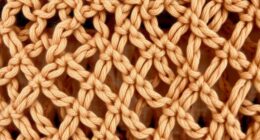To get stains out of your sofa, act quickly and identify the fabric type. For fresh stains, gently blot with a clean cloth to absorb moisture. Use a mild soap solution or natural cleaners like vinegar for surface stains, testing them on a hidden area first. For tougher stains, mix equal parts vinegar and water and blot the stain from the outside in to avoid spreading. Always avoid scrubbing too hard to prevent fabric damage. Regular maintenance, such as vacuuming, can help prevent new stains. Stick around to discover even more tips for keeping your sofa spotless and fresh! Additionally, learning how to maintain velour upholstery is essential for preserving its luxurious appearance. Regularly brush the fabric with a soft-bristle brush to keep the fibers upright and remove dirt particles. For deeper cleaning, consider using a steam cleaner—just make sure to follow the manufacturer’s guidelines to avoid any damage.
Key Takeaways
- Blot fresh stains immediately with a clean cloth to absorb moisture and prevent spreading.
- Identify the stain type and fabric to choose the appropriate cleaning method.
- Use a mild soap solution or natural cleaners like vinegar for surface stains, testing on hidden areas first.
- For persistent pet urine stains, mix equal parts white vinegar and water, gently blot, and rinse with cool water.
- Seek professional help for stubborn stains or delicate fabrics that require specialized cleaning techniques.
Introduction
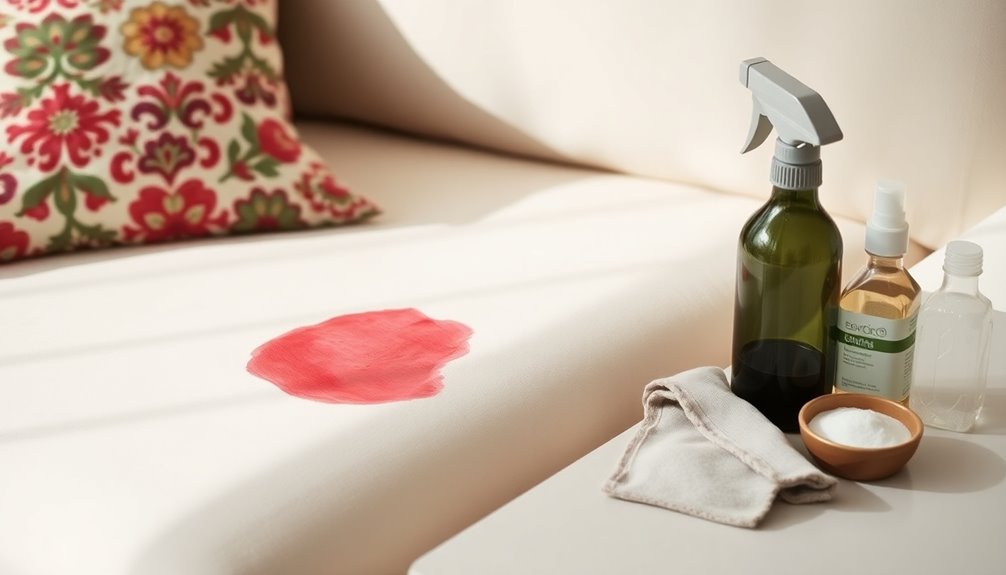
Keeping your sofa clean starts with a weekly vacuuming routine to prevent dirt buildup. You'll need to use material-specific cleaning techniques to ensure you don't damage the fabric. If you have pets, knowing how to tackle urine stains quickly can save your sofa from lasting damage. Regular maintenance, including emptying dust bins, can help maintain the overall cleanliness of your home, contributing to a fresher living environment.
Weekly Vacuuming Routine
Regularly vacuuming your sofa at least once a week is crucial for maintaining its appearance and hygiene. This simple cleaning routine helps prevent dust and crumbs from settling into the upholstery, keeping it looking fresh and clean. By vacuuming, you can also identify the true nature of stains since removing loose particles reveals their characteristics more clearly.
Frequent vacuuming not only aids in stain detection but also helps fade old stains. The dirt and debris that accumulate over time can make stains appear more prominent, so regular maintenance is essential. As you vacuum, you're effectively eliminating these contributing factors, which can prolong the life of your upholstery.
To ensure you're cleaning every inch of your sofa, use an upholstery attachment while vacuuming. This tool allows you to reach nooks and crannies that are often overlooked, ensuring a thorough clean. Remember, maintaining your fabric through regular vacuuming is key to preventing wear and tear. By establishing this weekly routine, you'll keep your sofa looking its best and extend its lifespan, making it a worthwhile investment in your home.
Material-Specific Cleaning Techniques
Understanding the unique cleaning requirements of different upholstery materials is essential for maintaining your sofa's appearance and longevity. Different fabrics come with specific cleaning codes that guide you on how to approach stain removal. For instance, water-safe fabrics coded "W" can be cleaned using water-based cleaning solutions, while solvent-only fabrics labeled "S" require dry-cleaning methods.
If you have a microfiber sofa, regular maintenance with a damp cloth and appropriate upholstery cleaners is key to avoiding damage. Leather sofas, on the other hand, need specialized leather cleaners and conditioners to prevent cracking. If your sofa fabric lacks a care tag, be cautious; always conduct a spot test in an inconspicuous area to assess how the fabric reacts to your chosen cleaning solution.
For vintage or antique pieces, it's best to consult professionals, as these fabrics can be more delicate and may not have clear cleaning instructions. A simple yet effective cleaning solution, like a mix of vinegar and dish soap, can tackle various stains without risking damage. Stay mindful of your sofa's material, and you'll keep it looking great for years to come!
Targeting Pet Urine Stains
Dealing with pet urine stains on your sofa can feel like an uphill battle, but acting quickly can make a world of difference. Pet urine stains can penetrate deep into upholstery fibers, so immediate action is essential for effective removal and odor control. Start by mixing one cup of white vinegar with one cup of cool water. Spray this solution onto the stain, ensuring you don't soak the area. The vinegar helps neutralize odors while lifting the stain.
Next, grab a clean cloth and gently blot the stain, working from the edges toward the center. This technique prevents the urine from spreading further into the fabric. After blotting, it's crucial to rinse the cleaned area with cool water to eliminate any remaining cleaning solution and odors.
If the stain persists, don't hesitate to repeat the cleaning process. For particularly stubborn stains, consider consulting professional upholstery cleaning services. They have the tools and expertise to fully remove pet urine stains and odors, ensuring your sofa stays fresh and clean. Remember, acting fast is key to maintaining your upholstery and preventing lasting damage.
Sofa Shielding Techniques
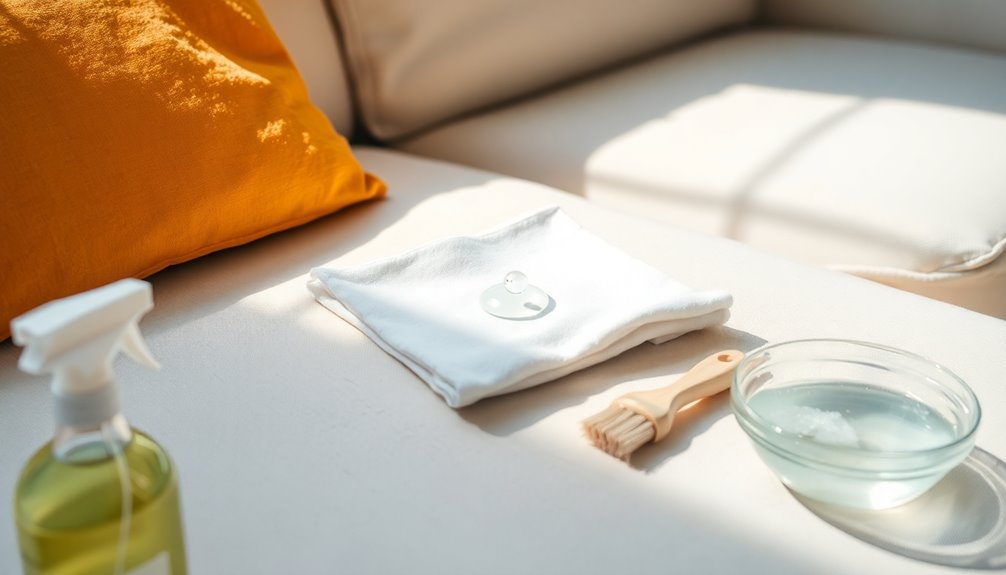
When it comes to keeping your sofa stain-free, choosing water-resistant fabric options is a smart move. You might also consider using furniture coasters to prevent spills and scratches from everyday use. By incorporating these shielding techniques, you can significantly extend the life and appearance of your furniture.
Water-Resistant Fabric Choices
What if you could enjoy your sofa without constantly worrying about spills and stains? Choosing water-resistant fabrics is key to making this a reality. Fabrics like treated microfiber and synthetic blends are designed to repel liquids, significantly reducing the chances of staining from accidental spills. When shopping for a new sofa, look for materials labeled as "water-resistant" or "stain-resistant," ensuring easier maintenance.
To enhance the protective qualities of your sofa, consider applying a protective upholstery spray. This creates an additional barrier against moisture, helping to keep your sofa looking fresh. Regular maintenance plays a crucial role, too. Make vacuuming a habit to remove dust and debris that can weaken the fabric's defenses.
If you've already got a sofa, check if it has water-resistant coatings like Teflon or Scotchgard for extra protection. Even with these options, you should still be ready for minor mishaps. Quick spot cleaning can help maintain the fabric's integrity. By taking these steps, you can enjoy your sofa without the constant worry of stains ruining your relaxation time. Additionally, understanding energy-efficient appliances can help you choose the right tools for cleaning and maintaining your home environment.
Protective Fabric Options
Even with water-resistant fabrics, taking extra steps to protect your sofa can enhance its durability and appearance. One effective strategy is to choose protective fabric options, like stain-resistant fabrics. Materials such as treated microfiber or synthetic blends can significantly repel spills and stains, keeping your sofa looking fresh.
To further safeguard your upholstery, consider applying upholstery protection sprays. These create a barrier that helps repel stains and liquids, making it easier to clean spills before they set in. Regular maintenance is crucial as well; vacuuming and spot cleaning reduce dirt accumulation that can penetrate fabric fibers, ensuring your sofa stays in top shape.
Another smart move is to invest in removable cushion covers made of machine-washable materials. This simplifies the cleaning process and allows you to maintain hygiene effortlessly. Additionally, don't hesitate to call in professional cleaning services or use fabric care kits periodically. They can help maintain the integrity and appearance of your upholstery over time, ensuring your sofa remains a beautiful and inviting part of your home. Additionally, consider exploring scholarships for flight training as a means to potentially cover cleaning costs through aviation-related opportunities.
Using Furniture Coasters
To keep your sofa looking its best, using furniture coasters is a simple yet effective technique. These coasters are essential for protecting your upholstery from scratches and dents caused by heavy furniture or objects. By elevating items off the surface, coasters can also help prevent stains from setting, making cleanup of spills easier and more efficient.
Choosing the right type of furniture coasters, whether rubber or felt, is crucial based on your flooring and the weight of your furniture. Regularly inspecting and adjusting these coasters ensures they remain effective, preventing potential damage from shifting furniture. This proactive maintenance can significantly extend the life of your sofa, saving you money on repairs and additional cleaning.
Incorporating furniture coasters into your home not only maintains your sofa's integrity but also enhances its overall appearance. It's a small investment in preventive care that pays off in the long run. So, take a moment to assess your furniture setup and add coasters where needed. This simple step can keep your sofa looking new and help you avoid frustrating stains and damage down the line.
Couch Frame Reinforcement Techniques
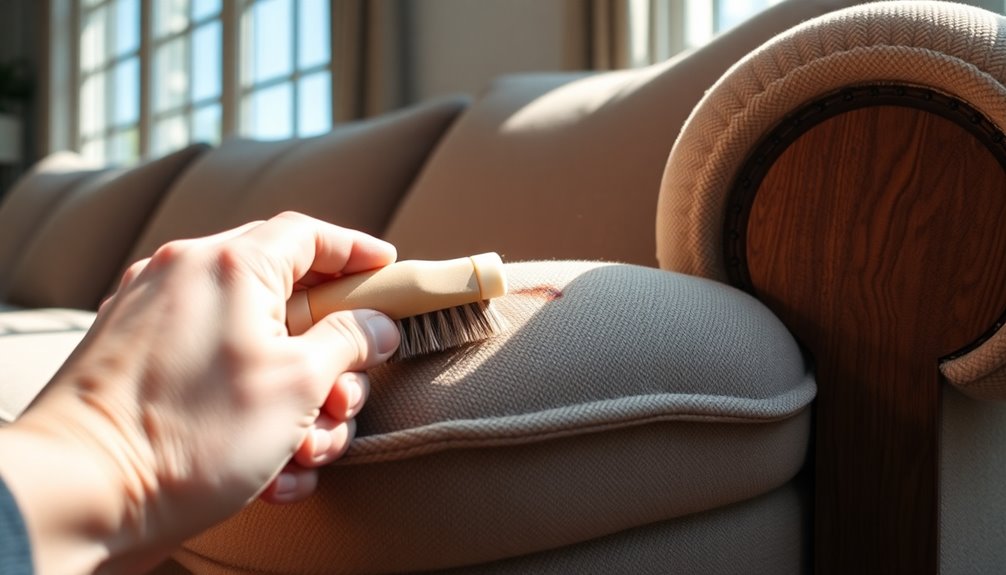
When it comes to maintaining your sofa, focusing on frame stability is key. You'll want to consider reupholstering with quality materials to enhance durability and revitalizing upholstery for a fresh look. By reinforcing the frame, you can prevent future sagging and ensure your couch stands the test of time.
Frame Stability Concerns
A sturdy couch frame is essential for ensuring long-lasting comfort and support in your living space. To enhance frame stability, consider adding corner braces, which provide additional support to joints and prevent wobbling over time. If your couch is older or heavily used, placing plywood sheets beneath the cushions can help distribute weight evenly and improve the overall structural integrity.
Regular maintenance is key. Tighten all screws and bolts periodically to maintain frame stability and avoid creaking or shifting. You can also incorporate brackets or metal plates at critical stress points, significantly enhancing durability and prolonging your furniture's lifespan. Additionally, ensuring that your couch is placed on a level surface can further stabilize the frame and prevent any unnecessary strain.
Don't forget the importance of routine inspection. Regularly check for worn or damaged components, such as legs or support beams. Addressing these issues promptly will ensure proper support and prevent further deterioration of the couch frame. By proactively reinforcing your couch, you can combat wear and tear, ensuring it remains a reliable fixture in your home for years to come. Taking these steps not only boosts your couch's longevity but also maintains its comfort and aesthetic appeal.
Reupholstering With Quality Materials
Reupholstering your sofa with quality materials not only enhances its appearance but also reinforces its frame for improved longevity. Many sofa frames are made from softwood, which can weaken over time without the right support. To combat this, consider techniques like adding corner blocks or using metal brackets to significantly improve frame stability and prevent sagging.
When repairing your frame, utilize high-quality plywood or solid hardwood, particularly in high-use areas, to ensure durability and strength. These materials will provide the necessary support and integrity to your reupholstered sofa. Regularly inspect and tighten any screws and bolts to prevent structural issues from escalating, maintaining the overall integrity of the frame.
Additionally, incorporating a robust spring system can enhance comfort and support, further reinforcing the quality of your reupholstered piece. By paying attention to these frame reinforcement techniques, you'll not only create a stunning sofa but also one that stands the test of time. Investing your effort in these details ensures your sofa remains a centerpiece in your home for years to come.
Revitalizing Upholstery Quality
Revitalizing your sofa's upholstery quality starts with a sturdy frame, essential for both comfort and longevity. A well-reinforced frame can significantly enhance the durability and stability of your sofa, allowing you to enjoy it for years to come. Begin by inspecting the frame for any signs of wear, like creaking sounds or wobbly legs. If you notice these issues, it's time to tighten loose screws or bolts.
Consider adding corner blocks or using metal brackets for extra support. Upgrading to hardwood or plywood instead of weaker particle board can also improve your sofa's overall strength. Additionally, applying upholstery glue or wood glue to joints and seams can bind components together, enhancing stability.
Incorporating proper color accuracy in your upholstery cleaning process can help maintain the vibrancy of your sofa's fabric. While you're at it, keep in mind the cleaning dos and don'ts when tackling old stains. Regularly deep clean your upholstery and promptly remove stains to maintain its quality. By reinforcing the frame and adhering to proper cleaning techniques, you'll not only enhance your sofa's comfort but also prolong its lifespan, ensuring it stays a beloved centerpiece in your home.
Upholstery Color Change Options
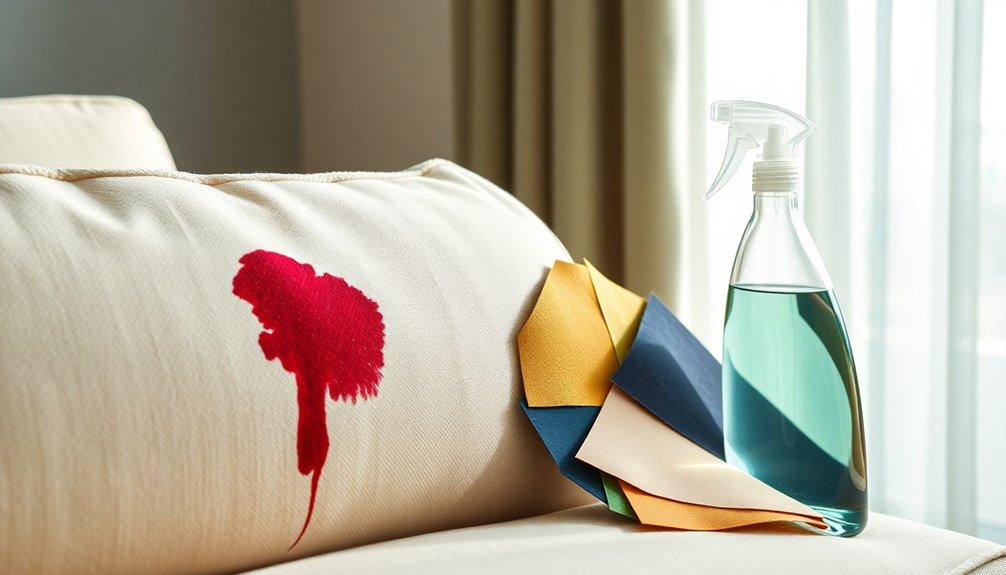
Transforming the look of your sofa can bring new life to your living space. If you're considering a color change, there are various options to explore. Dyeing your upholstery can refresh faded fabrics or completely transform the color, but make sure to consider the fabric type before proceeding.
For a more permanent solution, professional reupholstery services offer a new fabric covering, allowing you to select materials that suit your aesthetic. This option not only changes the color but also enhances the overall look of your sofa.
If you prefer a DIY approach, fabric paints and dyes specifically formulated for upholstery can be applied. Just remember to conduct a spot test first to ensure compatibility with your fabric.
To protect your newly colored upholstery from stains and fading, consider using upholstery protection sprays. These sprays create a barrier against potential damage, helping maintain your sofa's vibrant look over time.
Before you make any decisions, think about your room's overall decor. The new color should complement your existing furnishings and wall colors for a cohesive look.
Upholstery Maintenance for Longevity
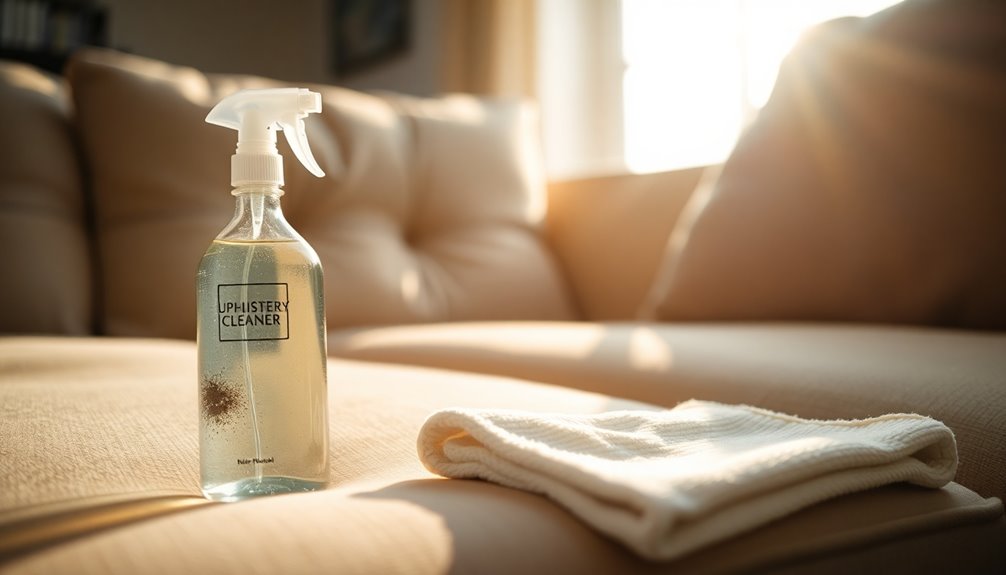
To keep your sofa looking great for years to come, regular maintenance is essential. Start by vacuuming your upholstery regularly. This simple step prevents dust and crumbs from settling into the fabric, helping maintain its appearance and prolonging its lifespan. When spills happen, act quickly by spot treating stains. The sooner you address them, the less likely they are to penetrate deeper into the upholstery, making future cleaning easier.
Consider using upholstery protection sprays as a preventative measure. These sprays create a barrier against stains and significantly reduce the chances of permanent damage. Always check and follow the cleaning instructions specific to your fabric type to ensure you're not risking damage during maintenance.
Incorporate periodic deep cleaning into your routine to keep your sofa looking fresh. This, combined with immediate attention to spills and stains, effectively extends the life of your furniture. By prioritizing cleaning and maintenance, you'll enjoy your sofa's beauty and comfort for many years.
Conclusion
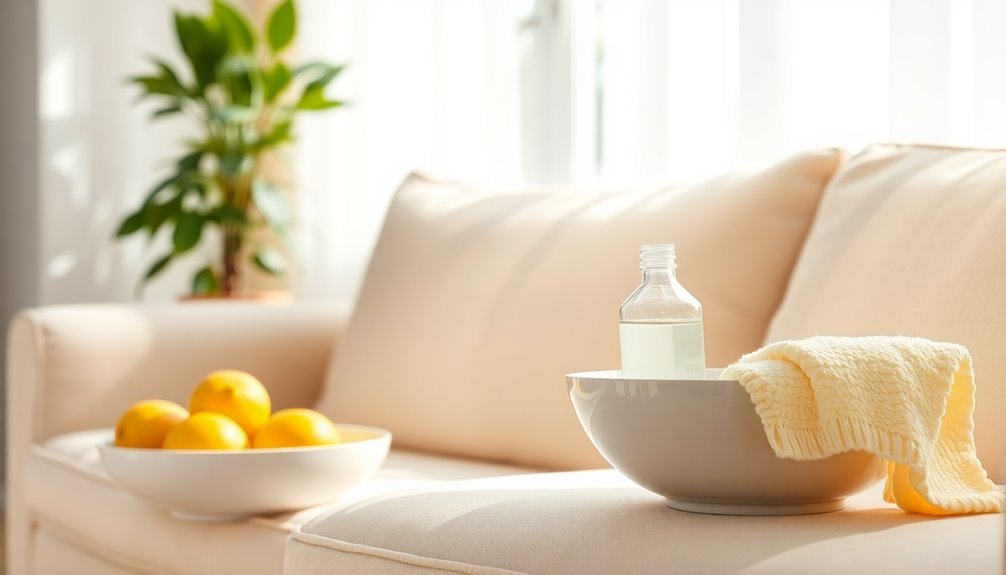
Maintaining your sofa is just the beginning; knowing how to tackle stains effectively will keep it looking its best. Quick action is essential when removing stains, as they can penetrate deeper over time, making them more challenging to eliminate. Always check the care tag to identify your sofa's fabric type, as this will guide your choice of cleaning method.
For everyday spills, you can often rely on natural ingredients like dish soap, vinegar, and baking soda. These household solutions work well for various stains when applied promptly. However, if you're dealing with stubborn stains, a hidden area may be the best place to test commercial cleaners.
Regular vacuuming and maintenance can prevent dirt buildup, which reduces the likelihood of deep-set stains. If you find yourself facing old stains that resist DIY methods, don't hesitate to seek professional help. Improper techniques can worsen the damage, so knowing when to call the experts is crucial. By understanding how to address stains, you can extend your sofa's life and keep it looking fresh for years to come.
Frequently Asked Questions
How Do You Get Stains Out of a Fabric Couch?
To tackle stains on your fabric couch, first, check the care tag for cleaning codes. Blot fresh stains immediately with a clean cloth—don't rub! For greasy spots, sprinkle baking soda or cornstarch, let it sit, and vacuum. A mixture of dish soap and warm water works well; apply it with a sponge and blot gently. Always test any cleaning solution on a hidden area first to avoid discoloration or damage.
How Do You Get Dried Stains Out of Fabric?
To get dried stains out of fabric, start by vacuuming the area to remove loose debris. Then, apply a suitable cleaning solution and let it sit longer for old stains to break down. For ink stains, mix one tablespoon of white vinegar with two-thirds cup of rubbing alcohol, gently blotting the stain. You can also use a baking soda paste; let it dry, then vacuum. Always spot test first to avoid damage.
How Do You Get Unknown Stains Out of a Couch?
When tackling unknown stains, start by vacuuming to reveal the stain's true nature. Test cleaning solutions on a hidden fabric area to avoid damage. For stubborn stains, mix baking soda with water, apply it for 10 minutes, then vacuum. Gently blot the stain using a dish soap and water solution or vinegar. If it doesn't budge, consider reaching out to professional cleaners, especially for delicate fabrics, to prevent any mishaps.
What Is the Hardest Stain to Remove From a Couch?
When it comes to stains on a couch, red wine is often the toughest to tackle. It seeps deep into fabric fibers, making it essential for you to act quickly. Grease stains, like those from butter or oil, can leave a stubborn residue that resists water-based cleaners. Ink stains are tricky too, as they spread easily if you're not careful. Pet stains combine liquid and odor, complicating their removal even further.
